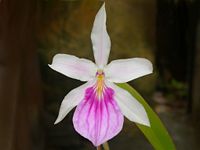Miltonia
| Miltonia | ||||||||||||||||||||
|---|---|---|---|---|---|---|---|---|---|---|---|---|---|---|---|---|---|---|---|---|
 Miltonia spectabilis
| ||||||||||||||||||||
| Scientific classification | ||||||||||||||||||||
| ||||||||||||||||||||
| Type species | ||||||||||||||||||||
| Miltonia spectabilis Lindl. 1837 | ||||||||||||||||||||
| Species | ||||||||||||||||||||
| ||||||||||||||||||||
| Synonyms | ||||||||||||||||||||
Miltonia is an orchid genus formed by nine showy epiphyte species and seven natural hybrids inhabitants of Brazilian Atlantic Forest, one species reaching the northeast of Argentinaand east of Paraguay. This genus was established by John Lindley in 1837, when he described its type species, Miltonia spectabilis. Many species were attributed to Miltonia in the past, however, today, the species from Central America and from cooler areas on northwest of South America have been moved to other genera.
Miltonia remaining species in are nine but they may be up to eleven when Miltonia flava, a species from Rio de Janeiro which presents identification difficulties, and Phymatochilum brasiliense, by some taxonomists included in this genus, are considered. There are also two natural hybrids which are not properly identified as yet.